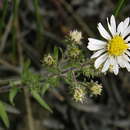Comments
provided by eFloras
Symphyotrichum falcatum is introduced in Ontario and Illinois. It may closely resemble S. ericoides, which has smaller heads with fewer florets in denser arrays. The two can be difficult to distinguish on the Great Plains. A. G. Jones (1978) recognized two subspecies of S. falcatum, one with two varieties. Those two subspecies are treated as varieties here.
- license
- cc-by-nc-sa-3.0
- copyright
- Missouri Botanical Garden, 4344 Shaw Boulevard, St. Louis, MO, 63110 USA
Description
provided by eFloras
Perennials 10–80 cm (colonial or cespitose, eglandular; with branched rhizomes or with ± cormoid, branched, woody caudices. Stems 1–5+, ascending to erect (grayish brown to brown), moderately to densely hairy. Leaves (light grayish green) firm, margins entire, strigose, apices ± spine-tipped; basal withering by flowering, sessile, blades oblanceolate, 10–40 × 3–10 mm, bases attenuate, margins usually entire, rarely remotely serrate, scabrous, apices acute to obtuse, rounded to mucronulate-spinose, faces glabrate to moderately strigose; proximal cauline sessile, blades linear oblanceolate to oblong, 10–40(–60) × 1.5–4(–7) mm, reduced distally, bases cuneate, margins entire, coarsely ciliate, apices acute or obtuse, faces sparsely to densely appressed hispido-strigose; distal sessile, blades linear-oblong to linear-lanceolate, 25–45 × 2–3 mm, bases cuneate, margins entire, apices acute, faces moderately to densely strigose. Heads [(1–)10–200+] in racemiform to diffuse-paniculiform arrays (1–10+ per branch, usually not crowded). Peduncles 0.2–4 cm, densely hairy, bracts 1–3+, linear to lanceolate, densely hairy. Involucres campanulate, (4.5–)5–8 mm. Phyllaries in 3–4 series, outer oblanceolate to spatulate (1.5–2 mm), inner linear-lanceolate (3–4 mm), unequal, bases (whitish to tan) ± indurate in basal 1 / 2 – 3 / 4 , margins hyaline, scabrous proximally, green zones diamond-shaped, in distal 1 / 4 – 1 / 2 , apices (outer) acute to obtuse, clear spine-tipped, spreading to reflexed, (inner) acuminate to attenuate, faces sparsely to moderately hispid-strigose. Ray florets (15–)20–35; corollas usually white, sometimes blue or pink, laminae (8–)18–30 × 1.1–1.4 mm. Disc florets (8–)18–30; corollas yellow becoming brown, 2–2.5 mm, lobes triangular, 0.7–1.2 mm, glabrous. Cypselae dark brown, obovoid, not compressed, 2–2.5 mm, faint-nerved, faces densely strigose; pappi whitish, 4.5–6 mm.
- license
- cc-by-nc-sa-3.0
- copyright
- Missouri Botanical Garden, 4344 Shaw Boulevard, St. Louis, MO, 63110 USA
Synonym
provided by eFloras
Aster falcatus Lindley in W. J. Hooker, Fl. Bor.-Amer. 2: 12. 1834; Lasallea falcatus (Lindley) Semple & Brouillet; Virgulus falcatus (Lindley) Reveal & Keener
- license
- cc-by-nc-sa-3.0
- copyright
- Missouri Botanical Garden, 4344 Shaw Boulevard, St. Louis, MO, 63110 USA

